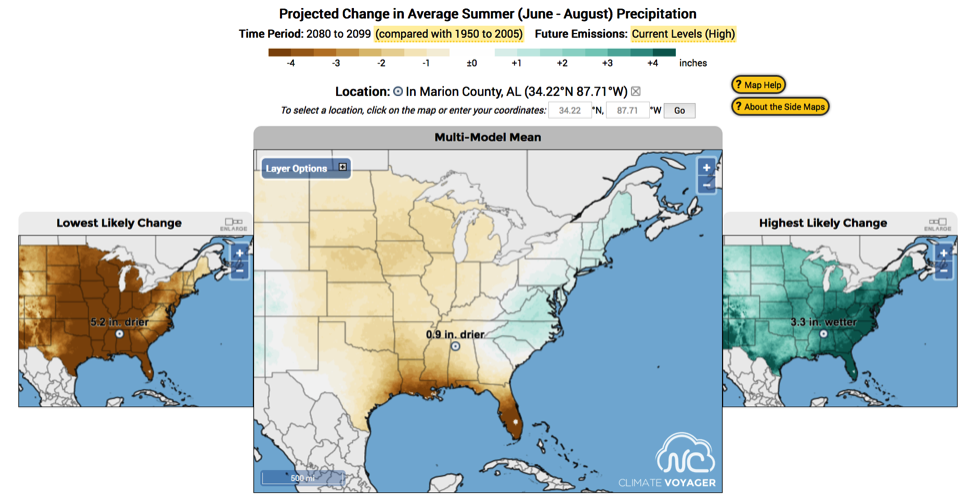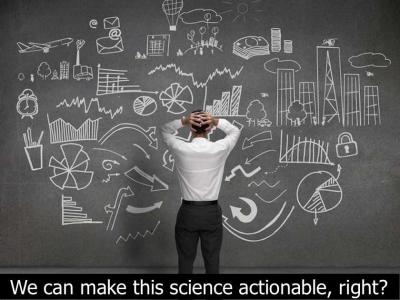JAN 8, 2017  RYAN BOYLES
RYAN BOYLES
On getting climate model projections in the hand of managers.

In the past several decades, climate scientists have developed robust models that simulate past climate conditions and provide meaningful projections for the future. In the past several years, researchers have developed downscaled climate projections that provide the kind of local guidance resource managers have been demanding. And now all those managers are making climate-informed decisions.

Time to wake up — we’ve been dreaming again about that ideal world where all managers have a basic understanding of climate science, climate models, and how to use them. But in my experience, most folks who want to use such guidance don’t yet have the capacity to handle the volume of data and technical aspects of climate model output. This brings up a question for climate scientists (and Climate Science Centers) — how do we help make our model data more usable? It’s not enough to deliver models. Delivering actionable science often means helping stakeholders develop the scientific and technical capacity to effectively understand and use climate projections.
Often, such scientific and technical assistance falls under a realm of scientific services that many researchers would rather not engage. After all, such services do not often result in scientific papers or proposals, which is the currency that most researchers need to succeed. But I argue that, given the enormous need and demand for such services to make climate science truly usable, researchers do need to interact with managers in these ways. Such engagement and services can lead to long-term relationships between researchers and managers that provide for sustained funding, scientific discovery, and meaningful publications.

So what services help ensure that climate projections are useable by our stakeholders? From my experience, there are usually 3 components: 1. Engagement, 2. Capacity Building, and 3. Synthesis. Often, these steps are iterative. Like removing the pine tree sap and mud that’s stuck on my car, I often have to repeat steps a few times before my efforts are effective.
Engagement involves the kind of work I traditionally think of as good ‘ol extension work. Meet with folks, listen to their needs, learn how they think, and get a sense of how they might benefit from the science. This is probably a universal first step for any actionable science. But I’ve only ever done climate work, so I’m speculating.
Capacity building is a fancy phrase for teaching. (I was a university professor, so I like fancy phrases – it makes me feel like I really did earn that PhD.) Some users might need a basic overview of the science. Others may have a good sense of the basics, but need more understanding of nuances in the science or data. When it comes to climate projections, I like a 3-part teaching outline that covers the basics of climate science, the basics of how climate models work, and some best practices on how to use model data. Some of these parts need more attention, depending on your stakeholder and how they plan to use the science we’re providing. Are they looking for general guidance on broad risks? Then basics on science and models are probably sufficient before pointing them to the National Climate Assessment. Do they want to feed climate data into a process model? You’re gonna need to spend time on the nuances of climate model uncertainties and best practices for using model data. Whether its tabular data or a more complex data visualization, your stakeholder will probably need you to synthesize climate projections into something they can actually use.
Synthesis, in this discussion, means data synthesis such as higher-level data products, data visualization, and perhaps even web tools to help your stakeholder access data and science at the right level of complexity. Engagement and capacity building steps often get repeated before moving into data synthesis. You and your stakeholder need to have a relationship that is sufficiently seasoned before you start connecting them to climate model data. They need to understand a single model output (or even a single downscaling product) will likely be insufficient to capture the full range of future possible climates. And yet, they will likely balk at the idea of using all the output from global climate models or multiple downscaling methods. Does your stakeholder have experience manipulating gridded model output? You might need to synthesize that daily output into the temporal scales, spatial scales, and a data format they can use. Do they understand the difference between model error and ensemble spread? Iterate on that engagement and teaching before they get too far down the rabbit hole. You might even want to spend a few days (or weeks) with them to help teach software for manipulating climate data. You’ll almost certainly need to keep those data processing and scripting skills fresh to deliver data in a way they can use it. After all, if they can’t use the data, the science may not be useful and certainly won’t ever become actionable.

You might balk at the time investment required to do all of this – indeed this kind of partnership building will eat at your clock like I eat at a Sushi bar1. But remember that you’re building a long-term relationship. You don’t want to be chasing random funding or every grant opportunity that comes along. Trust me – it’s exhausting. Instead, you want to build relationships with stakeholder so they get excited about you as a partner, theyconnect you to funding, and they develop a vested interest in your success. You become their climate science expert. They do the hard work of supporting you while you get to do the fun stuff. Whether you work in academic, government, or the private sector, building these kind of long-term relationships with stakeholders will foster your success and help make climate management efforts more successful on the ground.
